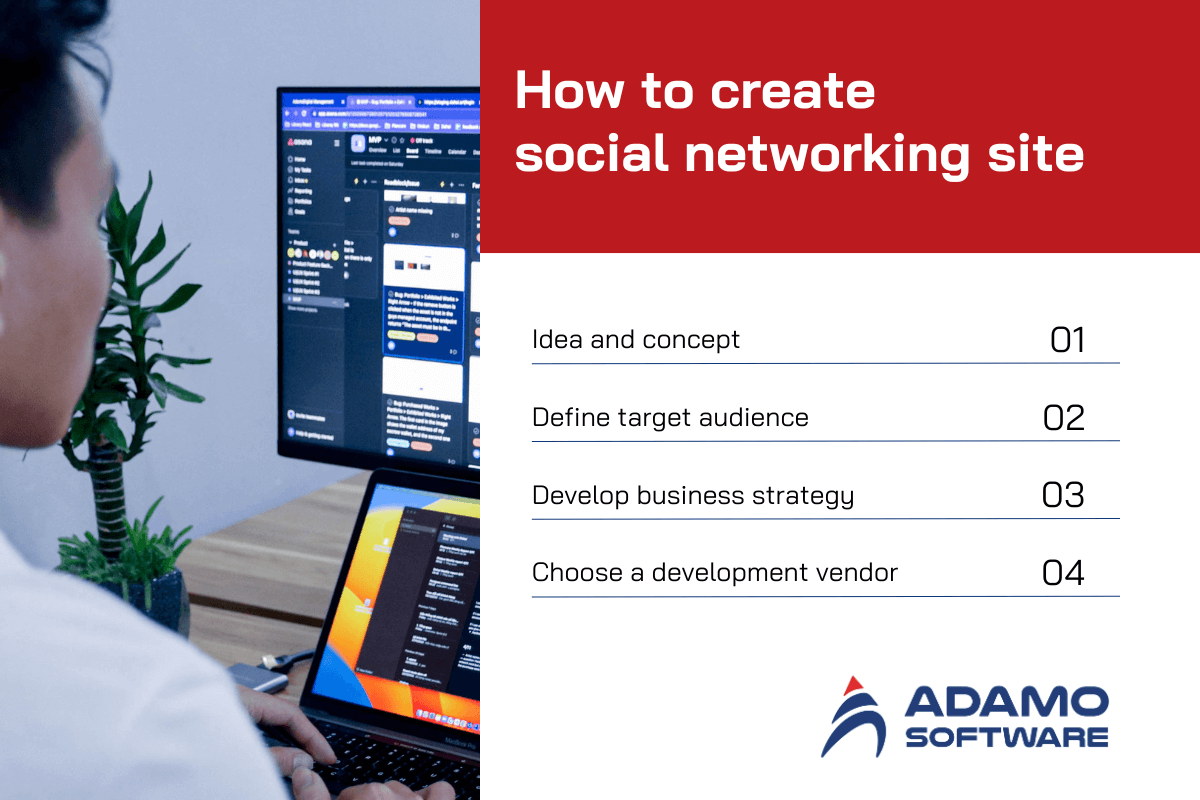What is Social Networking? How to Create Responsive Platform

What is social networking? It is noteworthy that virtually every person uses a minimum of 5 distinct social networking sites. Let’s look at how to create a site from the ground up.
Social networks are taking over the planet. They’ve taken our most important assets: time and attention. They’ve attracted billions of dollars in investments and let former ordinary students like Mark Zuckerberg to the ranks of the world’s wealthiest people. Each social networking site is a wide area of enormous opportunities.
Isn’t it amazing how easily these digital tools entered our lives and integrated into our habits? It certainly is. You have the possibility to join the top wealthiest people list in several years if you start creating a social networking site right now! Let’s look at what steps you should take to get closer to your objectives.
I. What is Social Networking?
Social networks are websites and apps that enable individuals and businesses to connect, interact, exchange information, and build connections. People can connect with others in the same area, as well as families, friends, and people who share similar interests. Social networks are one of the most important uses of the internet today.
Popular social networking sites, such as Facebook, Yelp, Twitter, Instagram, and TikTok, allow people to keep in touch, remain informed, and access, as well as share various information. These social networking sites also help marketers reach their intended audiences.
Social networking sites have gone a long way since the first social networking site, SixDegrees.com, was created in 1997. The world is rapidly adopting newer social networking platforms nowadays. According to DataReportal, a Kepios analysis from January 2022, revealed that there are more than 4.74 billion social network users worldwide.
II. How does social networking work?
The word “social networking” refers to having connections in both the physical and digital worlds. Today, this phrase primarily refers to online social communications. People can now find and connect with people they would never have met otherwise because of the internet.
Technology and internet connectivity are required for online social networking sites. Users can use their PCs, tablets, or cell phones to visit social networking sites. Most social networking sites rely on searchable databases that use advanced programming languages such as Python to organize, store, and retrieve data in an easy-to-understand way. For example, Tumblr employs Google Analytics, Google Workspace, and WordPress in its daily operations.
You can also explore Social Networking Analytics here to get a better understanding on social networking
III. Different types of social networking sites
1. Traditional social networking sites
Examples: Facebook, LinkedIn, X, Threads
Used for: Directly contacting clients in specific places, communities, or interest groups.
How your business can use them: Traditional social networking services are excellent for amplifying your message and connecting with your target audience. These adaptable platforms allow you to share both text and graphic information with anybody you want. They have the same features such as networking, event planning, and advertising.
Traditional social networking sites collect a lot of information about its members as well. This enables you to run customized ads and engage with the proper audience to give important information, promote upcoming local events or appearances, or run contests.
You may also utilize these platforms to communicate with customers directly using direct message options. These can be useful for clients who need quick responses to simple questions.
2. Image-based social media
Example: Instagram, Pinterest, TikTok (photo mode)
Used for: Visual storytelling, brand-building, and social commerce.
How your business can use them: Almost all image-based social networking sites lend themselves well to social commerce. They provide various in-app shopping options and eliminate the need to direct customers to an external site. By establishing a strong in-app shopping presence, you can sell directly to your clients.
Businesses can open a storefront on Instagram Shopping. You can include specific products in your photographs and videos, as well as mention them in the profile bio.
Pinterest Shopping allows you to connect to your store catalog and provide shoppable links to search results. You’ll also obtain a Verified Merchant badge on your profile, which gives clients a sense of assurance.
TikTok Photo Mode is an image-based structure for Instagram’s carousels. Users can add music to their photographs, and viewers can swipe through them or let them scroll automatically.
This format is ideal for showcasing product groupings, announcing a sale or contest, or telling longer stories.
3. Short-form video social media
Example: Instagram Reels, TikTok, YouTube Shorts
Used for: Sharing short-form video content (usually between five seconds and ninety seconds long)
How your business can use them: Short-form videos are excellent for increasing brand recognition and bringing products to life.
This form of content is easy to capture and edit, making it ideal for companies with a small social marketing team. Are you stuck for ideas? Because of the ongoing flow of trends on each channel, inspiration for your next short-form video is at your fingertips.
4. Livestream social media
Examples: Facebook Live, Instagram Live, TikTok Live, Twitch, YouTube
Used for: Broadcasting live video to many viewers at once
How your business can use them: The popularity of live streaming skyrocketed throughout the outbreak. You can utilize live streams to promote new products or interview well-known guests. Live discussions and polls are common aspects of livestreams. They also let users interact with the hosts in real-time. Therefore, it’s critical to monitor and respond to comments during the stream.
5. Discussion forums
Examples: Reddit, Quora
Used for: Questioning and replying, networking, and forming communities around specialist and interest-based issues.
How your business can use them: It might be difficult for businesses to break into discussion forums. Users are naturally suspicious of businesses that put PR-speak into a community-oriented forum.
The secret to succeeding in discussion forums is to provide value to your clients. Provide subject matter expertise and answer questions about your industry. Listen to their concerns and give practical solutions.
6. Private community platforms
Examples: Discord, Facebook Groups, Patreon, Slack
Used for: Creating communities, with the option of requiring registration or other forms of screening for new members.
How your business can use them: Private groups bring individuals from your community together. They can bond over common struggles and help each other answer issues without being distracted by unrelated conversations.
You may utilize your private community to interact with consumers, solicit user-generated content, and organize contests and promotions that add value to members’ experiences. You can also use the group welcome page to ask questions of members and learn more about your target audience.
7. Decentralized social networks
Examples: Bluesky, Mastodon
Used for: Increasing brand exposure, connecting with your community, and keeping an eye on current topics.
How your business can use them: Most social networking sites discussed so far run on centralized servers. Everything on one business’s servers is under the control of one company.
However, unlike traditional social networking sites, decentralized platforms disseminate data across multiple servers. That implies your data isn’t confined to a single server and isn’t controlled by a single company. Users can find and communicate with communities across servers without fear of data collection or restriction.
Mastodon is a non-profit organization, and they are unlikely to ever allow advertising. Bluesky will continue to be invite-only and ad-free. Nonetheless, many firms operate on both social networking sites. They only use them to form communities, conduct market research, and grow their brands.
IV. Explore the purpose of social networking sites
1. Demographics Research
Social networking sites are specialists at gathering information about people. A lot of this data is available to business owners via demographic data platforms like Facebook Insights. Using this tool allows you to narrow demographics, identifying not only potential consumers’ general interests but also their specific interests and purchasing habits.
You can establish a large demographic target with niche market segmentation using the research resources at your disposal. This enables you to create more successful marketing tactics.
2. Immediate customer feedback
One of the most effective ways to receive immediate and reliable customer feedback on your company’s products or services is to use social networking sites. Monitoring social media comments on your products or services can offer ongoing information on how – and why – customers like or dislike what you’re selling.
Aside from giving such vital information, social networking sites allow your company to reply to clients promptly. For example, if a consumer says something about having trouble assembling or operating a device your firm offers, someone from your customer support department can promptly assist them online.
3. Increase website traffic
Social networking sites can help improve traffic to your company’s website as well as sales and earnings in a variety of ways. For starters, social networking boosts your organization’s overall online mention, which can assist in boosting your SEO ranking and positioning your firm higher in online search results. Second, including direct online links to your company website in social media posts will help drive more traffic to your site.
4. Builds brand loyalty
Social networking sites foster a sense of community among their users. Therefore, they can provide a significant boost in creating brand loyalty to your company’s products or services.
Being active on social media websites helps to “humanize” your brand and fosters a sense of personal connection with both potential and existing clients. Customers who sense a personal connection with your firm are more likely to stay with you and avoid switching to a competitor.
Directly responding to consumer comments about your products or company builds customer loyalty. Furthermore, merely being present on social networking sites means that your company’s emblem and brand message are seen by possibly millions of people regularly.
V. Explore the best social networking sites
1. Facebook
According to Statista, Facebook is the most popular social networking site, with over 3 billion people using it monthly. This means around 37% of the world’s population uses Facebook. Facebook Messenger, a direct messaging spin-off app, has 931 million monthly active users.
More than 200 million businesses (mainly small businesses) utilize Facebook tools, and more than seven million advertisers actively promote their business on Facebook, making it a very secure pick if you want to have a social networking site presence.
2. X (formerly Twitter)
X encourages an audience that enjoys posting news, entertainment, sports, politics, and other topics. What distinguishes the platform formerly known as Twitter from most other social networking sites is its emphasis on real-time information – things that are happening and trending right now — in only 280 characters (140 for Japanese, Korean, and Chinese).
Many brands utilize Twitter as an additional channel for customer support. According to Twitter marketers, Twitter handles more than 80% of social customer support requests. In addition, Salesforce refers to Twitter as the “New 1-800 Number for Customer Service.”
3. LinkedIn
LinkedIn is an online social networking site for business people that focuses on professional networking to help them find a job, locate sales leads, and connect with possible business partners. Unlike most other social networking sites, LinkedIn does not prioritize establishing new connections or sharing media such as images, videos, and music.
To begin using LinkedIn, you must first sign up and establish a profile page. To join LinkedIn, you must first supply personal information. You can edit your profile with information about your schooling, job, and a summary. You can also make and get recommendations from coworkers and managers. LinkedIn has more than 75 million professionals enrolled.
4. Bebo
Bebo is the second most popular social networking site in the United Kingdom. It allows users to build free social networking profiles. Moreover, Bebo allows you to create a free account and upload photographs, videos, and information. Using a distinctive user experience, the site allows you to reconnect with old friends and make new ones. Users from more than a dozen nations visit the site, including the United States, Australia, Canada, Poland, France, and Germany.
5. Habbo
The Habbo online community is populated by pixelated cartoon alter egos. You can meet others in public places (nightclubs, restaurants, and shops) and build private rooms for selected friends. Employees at Habbo aggressively control the site, catering to its sizable young user base. Most Habbo users are between the ages of 13 and 18 years. Although most users are from the United States, Habbo social networking sites are popular in countries such as the United Kingdom, Japan, Sweden, Spain, Italy, Finland, and others.
6. Threads by Instagram
Threads, Instagram’s Twitter alternative, debuted in app stores in 2023, with a record-breaking rise to 100 million sign-ups in a matter of days. While interest in the platform appeared to be waning at first, Threads has consistently introduced new features to keep monthly active users growing.
According to Facebook CEO Mark Zuckerberg, Threads has “just under” 100 million monthly active users and has a “good chance” of reaching 1 billion users in the next five years.
7. NING
Ning is the largest social networking site for organizers, activists, and influencers around the world to create social experiences that drive action. It enables you to establish a safe and secure online environment for like-minded individuals. Ning takes the concept of groups to an entirely new level. Because of the flexibility to construct your own community, Ning is an excellent home away from home for companies and groups trying to fill the social void.
8. Classmates
Classmates.com differs from most social networking sites in that most features are only available to premium members. The cost of premium membership is determined by the length of the agreement; a shorter period results in a higher monthly cost.
This social networking site is mostly used to reconnect with former classmates. The website has a search engine that allows you to see other people who went to the same school as you. It is free and simple to create a basic Classmates.com profile. However, most of Classmate.com’s advanced capabilities are only available to premium subscribers.
9. Mastodon
Mastodon, a new social networking site, skyrocketed in popularity in late 2022, rising from 300,000 to over 1.7 million monthly active users in 2023.
It is an open-source, decentralized software that lets users build up servers to connect. Users can publish up to 5,000 characters and include photos, audio, and video.
10. Multiply
Multiply is a vibrant social shopping destination that is faster and more convenient for vendors and buyers. A user’s network consists of their direct contacts and individuals closely related to them through first-degree relationships. Users are also encouraged to describe the nature of their relationship with one another, allowing for relationship-based content sharing. The Multiply Marketplace has become a favorite shopping site for many buyers in the Philippines, Indonesia, Malaysia, Singapore, Thailand, and Vietnam.
11. Discord
Discord is a social networking site primarily designed for gamers. It enables users to create servers, join groups, and engage in real-time voice and text chat with others.
It is popular owing to its ease of use, configurable features, and device compatibility. Its application has spread beyond gaming communities to include corporations, educational institutions, and other groups.
12. Badoo
Badoo is a social networking site that is available in multiple languages. It is gaining traction in emerging economies like as Russia and Brazil. Users can build profiles, send messages, and grade one other’s profile images for free on the site. However, tools designed to make a user’s profile more apparent to other users come with a cost. Badoo has a geographic proximity function that identifies users’ whereabouts based on network connection analysis. This notifies users if there are others around who might be interested in meeting.
13. SkyRock
SkyRock.com is a social networking site that provides free online space for its members to build blogs, add profiles, and exchange messages with other registered people. The site also has a section for members who want to showcase their musical compositions through blogs. SkyRock is extremely popular in France and other French-speaking countries such as Switzerland and Belgium. The website is also available in English, German, Dutch, and Spanish. It is extremely popular in the European Union.
14. StudiVZ
StudiVZ is Germany’s largest social networking site. It is also popular in German-speaking nations such as Switzerland and Austria. This website serves as a student directory, mostly for European college and university students. Students can create a personal page on the site that includes personal information such as their name, age, study subjects, interests, courses, and group memberships (inside StudiVZ).
15. Kaixin001
In China, Kaixin001 is a popular professional social networking site. Kaixin’s target demographic is typically white-collar middle-class people from a first-tier city. This site is immensely popular in China among people who work for multinational corporations, ad agencies, and other white-collar businesses. Kaixin001 has grown in popularity significantly since 2009, when social networking sites such as Myspace, Facebook, Twitter, and YouTube were restricted in China.
VI. How to create a social networking site: The Ultimate Guide

1. Idea and concept
The building of a social networking site should begin with an original idea that will be translated into a concept. This is a crucial consideration because your network should be able to win users over. The following questions will help you learn how to create a stand-out social networking site:
– What unique features will set your social networking site apart from the competition?
– What is the website’s core concept?
– What value do you have to offer potential users?
Care2, Dogster, and Untappd are examples of niche networks that provide value to customers, are distinctive, and bring users together based on their hobbies. If you design something similar to one of these, your social networking site has a better chance of being famous.
2. Define target audience
As you explore a product idea and decide how to develop the best social networking site from scratch, you need also to evaluate who your target audience is – who potential users could be interested in your product. Knowing their age, geography, financial standing, and hobbies is not enough; you must consider the target audience in terms of numbers.
Assume you’re looking for information on how to construct a social networking site for water gun collectors. How many people do you know who collects them? It makes no sense to invest in something that will not provide a return on your investment.
When you first inquire about social networking site construction, you should conduct preliminary research on your target audience. This research can be done online, where you can look up statistics, communities, and other information that will help you make your final decision.
The following step is to put an idea to the test on real individuals. You can approach members of communities of a specific interest both online and in person. The goal here is to determine how the social network concept will resonate with the target audience and to acquire insight into how to construct a social networking site that will convey your notion.
3. Develop business strategy
You’ve undoubtedly learned a thing or two about creating your own social networking site, but there are a few more vital items to cover.
It’s time to move on to the next level, which is all about developing a business strategy for your website.
The wants and needs of the community you intend to serve should dictate how you build a social networking site and what services you provide. What do your customers anticipate from you? How do you want them to interact with your social networking site? It is not difficult to determine what features to incorporate in social network web development once you have the answers to these questions.
You can begin with a lesser version of your app and then expand your network by adding new features and implementing cutting-edge technologies. If you have the resources, you may go bigger and launch a more feature-rich network or a full-fledged product all at once. The less dangerous method is to start small, but how you construct a social networking site is entirely up to you.
4. Choose a development vendor
You cannot decide how to establish a successful social networking site without first selecting the correct mobile and website development company. Unless you are a developer and are willing to make the effort on your own, you will need someone who can provide professional social networking development services. Because of the excellent price-quality ratio, IT outsourcing in Vietnam is a fantastic choice.
VII. Why Partners with Adamo to Build Optimal Social Networking Platforms
The trend of social networking market is increasingly demand for its tremendous benefits to business expansion and social connections for users. Understanding those benefits and market demands, Adamo will be a perfect tech partner for you to build an optimal social networking site with outstanding features and functionalities. Besides, our developers have experience of working with lots of partners in the media and entertainment industry, which helps transform business ideas in a lucrative software solution.











